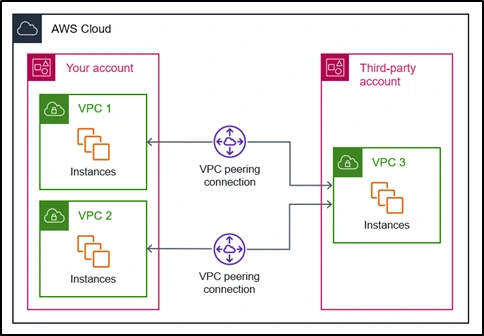|
Voiced by Amazon Polly |
Introduction
As more organizations move their IT infrastructure to the cloud, they often need to create and manage multiple Amazon Virtual Private Clouds (VPCs) to isolate and secure their resources. However, connecting these VPCs can be a complex and challenging task, especially if they are located in different regions or accounts. Two common solutions to connect Amazon VPCs are VPC peering and Transit Gateway.
In this blog, we will comprehensively compare VPC peering and Transit Gateway, exploring their features, benefits, and limitations. By the end of this blog, you will better understand which solution best fits your networking needs and how to optimize your Amazon VPC architecture.
Pioneers in Cloud Consulting & Migration Services
- Reduced infrastructural costs
- Accelerated application deployment
What is VPC Peering?
VPC peering is a networking solution that connects two VPCs in the same or different AWS regions using private IP addresses. VPC peering creates a direct, one-to-one connection between two VPCs, bypassing the internet and providing low-latency, high-bandwidth connectivity.

Fig: Architecture diagram of VPC Peering
Benefits of VPC Peering
- Simple and easy to set up: VPC peering can be created with just a few clicks in the AWS Management Console and does not require additional hardware or software.
- Low latency and high throughput: VPC peering allows you to communicate with instances in another VPC as if they were in the same network without incurring data transfer charges or exposing your traffic to the public internet.
- Flexible and scalable: VPC peering can connect VPCs across different accounts or regions and be deleted or modified anytime.
Limitations of VPC Peering
- Regional constraints: VPC peering can only connect VPCs within the same AWS region, which may limit its usefulness for global deployments.
- Overlapping IP addresses: VPC peering requires that the IP address ranges of the peered VPCs do not overlap, which can be challenging when migrating workloads or merging multiple VPCs.
- Limited scalability: VPC peering supports a one-to-one connection model, which may not be suitable for large-scale networks or complex architectures.
What is Transit Gateway?
Transit Gateway is a networking service that connects multiple VPCs, on-premises networks, or remote networks using a centralized hub-and-spoke architecture. Transit Gateway acts as a transit point for traffic between VPCs, providing a scalable and flexible way to manage your network connectivity. With Transit Gateway, you can easily route traffic between VPCs, enforce security policies, and integrate with other AWS services, such as AWS Transit Gateway Network Manager or AWS Global Accelerator.

Fig: Architecture diagram of Transit Gateway
Benefits of Transit Gateway
- Scalable and flexible: Transit Gateway can connect up to 5,000 VPCs and route traffic between VPCs in different AWS accounts or regions, as well as on-premises networks or remote networks.
- Centralized management: Transit Gateway allows you to manage your network resources in a single place, using features such as route tables, security groups, or VPN attachments.
- Advanced features: Transit Gateway supports route propagation, VPN failover, or domain name system (DNS) resolution, which can enhance your network performance and security.
Limitations of Transit Gateway
- Higher cost: Transit Gateway can be more expensive than VPC peering, especially for small-scale networks or simple architectures. You may incur additional charges for data transfer, VPN connections, or NAT gateways.
- Complexity: Transit Gateway has a more complex setup process than VPC peering, requiring you to create and configure multiple components such as route tables, attachments, or prefixes.
- Limited control: Transit Gateway may not offer as much granular control over network traffic as VPC peering, especially if you need to implement custom routing or security policies.
Comparing VPC Peering and Transit Gateway
Now that we have explored the basics of VPC peering and Transit Gateway, let’s compare them in terms of their features, benefits, and limitations:

Conclusion
Diving into this comparison, choosing the right solution for connecting your Amazon VPCs is crucial for achieving your IT infrastructure’s performance, scalability, and security requirements. While VPC peering is a simple and low-cost solution for connecting two VPCs within the same region, Transit Gateway provides a more advanced and centralized approach for connecting multiple VPCs across regions, accounts, and on-premises networks. By carefully evaluating your networking needs and considering the features and limitations of each solution, you can make an informed decision that optimizes your AWS network architecture and enhances your cloud infrastructure.
Making IT Networks Enterprise-ready – Cloud Management Services
- Accelerated cloud migration
- End-to-end view of the cloud environment
About CloudThat
CloudThat is an official AWS (Amazon Web Services) Advanced Consulting Partner and Training partner and Microsoft Gold Partner, helping people develop knowledge of the cloud and help their businesses aim for higher goals using best in industry cloud computing practices and expertise. We are on a mission to build a robust cloud computing ecosystem by disseminating knowledge on technological intricacies within the cloud space. Our blogs, webinars, case studies, and white papers enable all the stakeholders in the cloud computing sphere.
Drop a query if you have any questions regarding Amazon VPC and I will get back to you quickly.
To get started, go through our Consultancy page and Managed Services Package that is CloudThat’s offerings.
FAQs
1. Can I use VPC peering and Transit Gateway in the same VPC network?
ANS: – Yes, you can use VPC peering and Transit Gateway together to create a hybrid network topology that connects VPCs within the same region and across regions.
2. Can I use third-party tools or services to connect Amazon VPCs?
ANS: – Yes, many third-party tools and services can help you connect Amazon VPCs, such as software-defined networking (SDN) solutions, network virtual appliances (NVAs), and cloud-based routers.

WRITTEN BY Chamarthi Lavanya
Lavanya Chamarthi is working as a Research Associate at CloudThat. She is a part of the Kubernetes vertical, and she is interested in researching and learning new technologies in Cloud and DevOps.


 Login
Login


 May 25, 2023
May 25, 2023 PREV
PREV








Comments